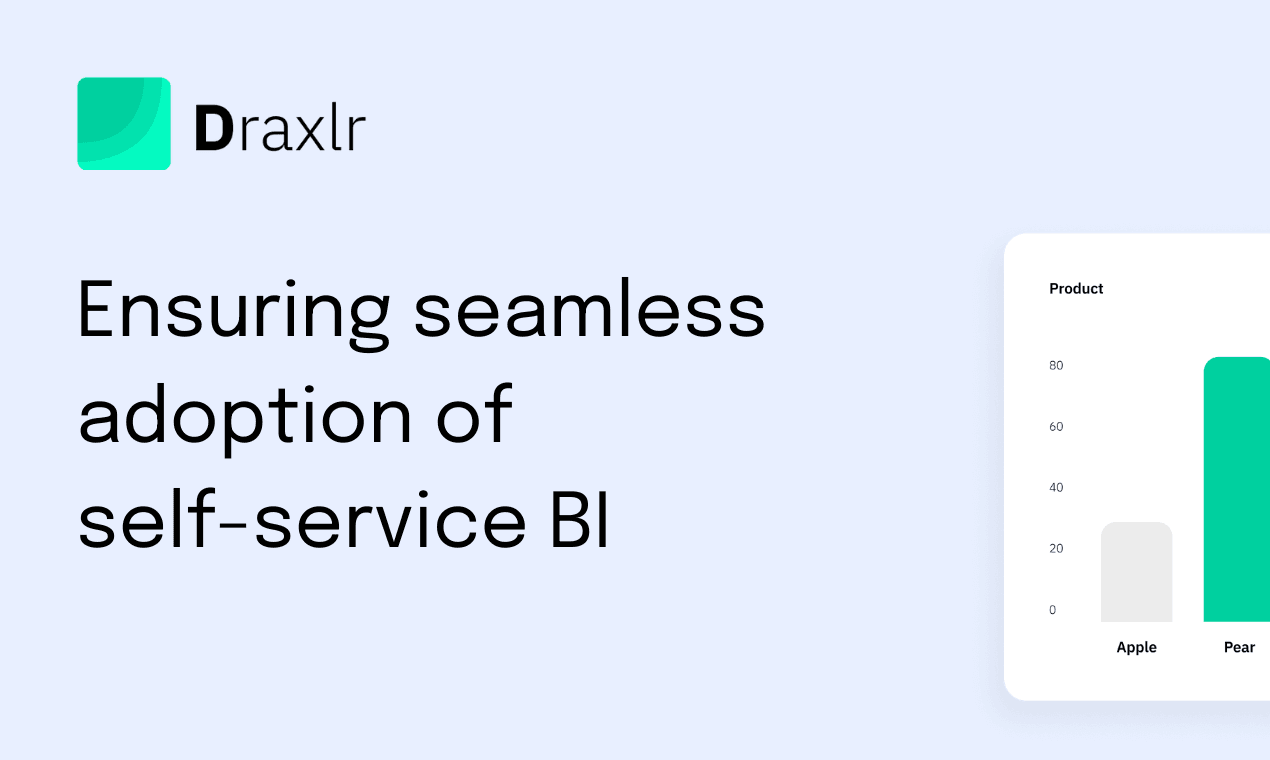Ensuring seamless adoption of self-service BI in your organization
Discover how to ensure seamless self-service BI adoption in your organization. Learn strategies to overcome challenges & boost user engagement effectively!

As self-service business intelligence aims to combat the issues associated with IT-driven BI solutions, more and more organizations are adopting these platforms to empower their business users and reduce their dependence on IT teams.
With self-service business intelligence software, everyone in the organization, regardless of their technical proficiency, can access, analyze, and visualize data independently, without relying on IT teams or data specialists. Self-service BI software brings numerous benefits, including boosting overall operational efficiency, raising the skill level of regular employees, and nurturing a data-driven business culture.
Yet, despite all the advantages, the widespread adoption of self-service BI solutions can still be slow. In this article, we’ll take a look at the possible issues that hamper the success of self-service BI in a company and provide tips on how to overcome them.
Self-service BI adoption: What can go wrong?
Among the critical challenges that self-service BI adoption faces are:
- Poor data quality residing in the source systems and data silos resulting in mismatches and fragmented data
- Lack of standardization within teams using different metrics and calculations leading to varying interpretations of data and analytics insights
- Data security and compliance because of the data being exposed to a larger number of users
- The growing number of users and data volumes leading to BI system performance degradation
- Over-engineering the solution with additional functionality resulting in complexity for business users
- High investments in software licensing, workforce training, system maintenance, and user support
- Additional efforts to ensure all users can fulfill their needs with the self-service BI platform, be it basic reporting and dashboard customization or more advanced tasks like creating and modifying semantic models
Strategies to boost self-service BI adoption
While self-service BI software can present more challenges than expected, with the right approach, it’s possible to drive its adoption.
1. Centralized data governance
Employees always get discouraged by the system that produces erroneous results affecting business decisions. The root issue, however, can lie not in the platform itself but in the quality of data coming into it. The thing is that without robust data governance practices established within the organization, varying data management practices can lead to data duplicates and inconsistencies.
In such a case, establishing centralized policies and procedures for data usage, security, quality, and access is essential. Solid data governance increases data trustworthiness and reliability, making it a source of value for all users.
Additionally, consider assigning data stewards in your organization. These are people oversee data quality and collection processes, enforce data policies, help mitigate data-related issues, facilitate communication between various data stakeholders, and prepare documentation, data dictionaries, and usage guidelines.
2. Choosing the right software
Self-service BI tools inherently aim to streamline data management tasks, namely, data integration from heterogeneous sources, raw data aggregation and processing, analytics querying, and report generation and sharing with team members. To enable all these tasks, look for technology options that offer:
- Drag-and-drop capabilities to move and manipulate digital data sets in an intuitive way
- Plug-and-play data links to automatically add and remove sources without manual configurations
- Custom dashboards that allow for the visualization of the most relevant data to users according to their roles
- Pre-built report and dashboard templates to streamline data visualization and analysis without compromising the reporting quality
- Natural language processing to ensure intuitive user experience
- Automated suggestions and recommendations to guide users through the data analysis process
Apart from that, for the self-service BI software to integrate with your ecosystem and support an uninterrupted data flow between systems, it should provide pre-built connectors and APIs as well as be compatible with popular middleware solutions. Additionally, check whether the BI system comes with round-the-clock customer support and rich documentation for employees to be able to find answers to their questions promptly.
Among the recent advancements that are worth looking for in BI software is artificial intelligence. According to Dr. Russell Hunter from the University of Cambridge, AI, particularly generative AI, helps automate manual tasks, enhance data visualization, and generate insights from large datasets, which makes complex tasks more accessible to regular users.
For the BI software to become a strategic asset, it’s also advisable to pick a scalable platform that accommodates its capacity to your business needs while offering a flexible pay-as-you-go pricing model.
3. Getting employee buy-in
For business users to utilize the self-service BI tool confidently, you should add user training to your agenda. Yet, it’s equally important to secure employee buy-in to ensure high software adoption rates. If business users consider the new platform just an additional time-consuming burden, they’ll give up the system and switch back to spreadsheets. Therefore, you must alleviate arising doubts and win your team over to be committed to your company’s strategic goals.
With employee commitment, a company can boost workplace productivity, as it elevates employee engagement, interest, and retention. To obtain the much-needed buy-in, follow these steps:
- Conduct a change management assessment and craft an all-embracing change management plan.
- Establish communication guidelines and channels and determine how and when to conduct training sessions and who’ll be responsible for developing and maintaining learning materials.
- Map data management processes in such a way that users have almost no chance to compromise data quality, security, and integrity by leveraging governed data access, role-based permissions, data access checks, approval workflows, and sensitive data identification and masking.
- Survey end users, such as team leaders, IT specialists, and team members of different business units before and during the implementation of the self-service BI tool, to assess their expectations, needs, and requirements. Collaborate with them post-launch and gather feedback, including suggestions, observations, and obstacles they face. Adjust your adoption strategy based on this information, such as conducting personalized user training sessions or adding customizable features that can enhance user experience, such as conversational AI or customizable dashboards.
If you lack the required expertise to get employee buy-in and foster user adoption, consider partnering with external specialists providing BI consulting and support services to augment your in-house team and guide your company throughout the intricate self-service BI implementation process.
To sum up
Companies opt for self-service BI to allow individuals at all levels of an organization to collect, consolidate, and analyze data without the need to apply IT expertise. This type of software addresses the problem of creating a backlog of tasks for IT teams, ensuring sufficient insights for diverse departments, and boosting operational efficiency. Yet, while self-service BI solutions are implemented to give business users the freedom to leverage the BI system independently of the technical team, numerous roadblocks can arise.
To drive user adoption, especially when it comes to business users who lack the required technological experience, companies should foster data literacy through training and detailed documentation, choose a tool that’s easy to learn, and make sure everyone clearly understands the value of the self-service BI solution and is eager to become proficient in it.

